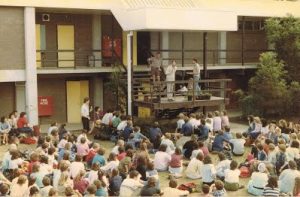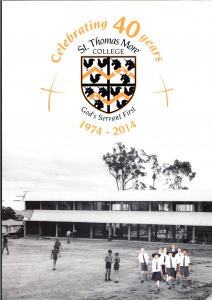The St Thomas More College History Project was commissioned in 2012. The history publication was produced in mid-2014.
The founding of the college happened at a major conjunction of changes in Catholic education, both for the country and the state. The college was in many ways an expression of educational and administrative developments happening in the Catholic and state systems during the early 1970s.
In a matter of months from the formation of the Queensland Catholic Education Commission and the Queensland Catholic Education Office, St Thomas More College is established as one of the first secondary school administered from the Brisbane Catholic Education Office, and the first Catholic all-laity-teaching-staffed secondary college in the country.
Those who brought about the conception of the St Thomas More College included Father Barney O’Shea, as Director of Catholic Education; the foundation lay staff: Principal, Mr Jim Slingsby, Mr Damien Barker and Mr Vince Coman; Father Hegarty, Parish Priest of Our Lady of Lourdes; and in the year after the opening of the college, the Presentation Sisters. After the original plans with the Brothers of St Gabriel failed, the key development during the college’s conception was the inability to find teaching staff from the religious orders, which was the original design for the first Brisbane Diocese’s secondary school.
The college as a laity-operated institution brought an important disjunction in the existing pattern of Catholic education in Queensland. Archbishop Rush publicly supported the new model of Catholic secondary education and the increased responsibility it would bring for the laity in the diocese. At the time, within the diocese, there were pockets of disquiet, and in some quarters, alarm about what could result from the increased ‘secularisation’ of Catholic schools and the perceived devolution of teaching responsibility from religious appointees. The diocese leadership in the first few years of the college were able to satisfy concerns and affirmed the Catholic mission of the college. The initial fears were quickly dispelled.
However, after a difficult first year with basic staff, infrastructure, and resources, the second year saw a major restructure in the College, bringing with it radical innovations in secondary education with further disquiet in the local Catholic community. At the heart of this restructure was a statement of the College’s philosophy that was expressed in the Pastoral Care program, the Presentation Sister’s program of Christian Living, student-lead curriculum, no corporal punishment, and no student uniform. In the following years, added to these innovations were the College’s Community Service and Work Experience programs.
Under the leadership of subsequent College Principals, particularly Damien Barker (Principal from 1983 to 1989) and Peter O’Connor (Principal from 1990 to 2002), a full range of conventional subjects was offered. The closing of the initial development of College was signalled by the withdrawal of the Presentation Sisters order from the college at the end of 1988. While retaining its position as a leading Catholic secondary college, the institution conformed to the normal pattern in Catholic education. In 1991, after much discussion from the Parents and Friends and the Administration, a student uniform was introduced, featuring the colours black and white and later a gold trim.
The beginning of the 21st century brought a major building and landscaping program, most notably under the leadership of Chris Noonan, Principal from 2003 to the end of 2009. This resulted in a new multi-purpose centre for Music, Drama and Physical Education, and a refurbishment of the Practical Arts building, officially opened by Archbishop Bathersby in 2011. Recent years has seen transformation in the curriculum and the college infrastructure with the introduction of computer laboratories, a college website, the use of Moodle to enhance student learning.
Was this article interesting to you?

Assembly with Damien Barker as Principal

 Press the Heart to Like!
Press the Heart to Like!
